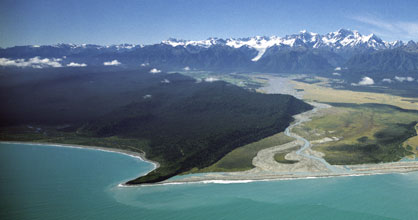
New science shows New Zealand is part of a continent that’s 94 per cent underwater. Will Harvie explains.
To most people, New Zealand comprises two large islands and a scattering of small and tiny ones. Its western edge is Fiordland, its southern edge Stewart Island. Its easternmost point is the Coromandel and its northernmost edge is at North Cape. It’s about 269,000 square kilometres.
To increasing numbers of geologists, however, New Zealand is actually part of a continent, a surprisingly ungainly one, but still a proper continent. To the north and west, this continent includes New Caledonia and almost kisses Queensland. To the south, it stretches well past the Auckland and Campbell islands.
To the east, it easily envelopes the Chathams and carries well out into the Pacific. It might include – scientists aren’t sure yet – two long, thin parallel antenna that would collect Fiji and Tonga. It could be 4.9 million square kilometres.
They call it Zealandia.
It happens to be 94 per cent underwater, but that doesn’t matter to geologists or palaeontologists. They aren’t swayed by current coastlines. Their timescales don’t start 20,000 years ago, the last Ice Age. They go back 150 million years, to the time of the supercontinent Gondwana.
Viewed from that perspective and relying on the most current science available, there are now seven continents: Eurasia, Africa, North America, South America, Australia, Antarctica and – yes! – Zealandia.
We’ve made the Continental Club. (Debate if you like whether the Americas can be split in two and the true number of continents. For this article, Your Weekend accepts the count of authors Mortimer and Campbell.)
“It’s an idea whose time has come,” says Nick Mortimer, co-author of a new 274-page book called Zealandia: Our Continent Revealed, published yesterday.
“We’ve been writing scientific papers about Zealandia for a few years now and . . . it was time to consolidate things and put out an authoritative statement,” the GNS geologist based in Dunedin says.
Peer-reviewed academic papers discussing – indeed, proving – Zealandia is a continent have been broadly accepted by the kinds of geologists interested in continents. (See page 14). Other geologists are perhaps unaware. “A lot of overseas geologists think their geology stops at the high tide mark,” Mortimer says.
Ad Feedback
“It comes down to branding,” he says. He means educating geologists and the public that Zealandia exists, and that it matters. “Identifying a continent is quite a big deal. It’s one of the fundamental divisions of planet Earth.”
And why does it matter
“Zealandia is of continental proportions and hence its potential energy and mineral resources are of continental proportions,” Mortimer and co-author Hamish Campbell write. “To date, New Zealand and New Caledonia have barely started exploring beyond their immediate shores.”
The authors are confident the geography and geology of Zealandia will lead to “sustainable living standards and cultural and environmental security well into the future”.
Zealandia the continent also says something about biodiversity. “Life, death, evolution, extinction and change are what happens on planet Earth. In our Zealandian melting pot, as species become extinct so new hybrids and species will evolve. Nature is no conservationist,” they write. The long, geological view is “rarely raised in discussions of modern biodiversity”.
There’s also a chance for new
understandings. For example, some peoples of the South Pacific now have more in common than our recent human past. We should also clamour for smaller things: Climbers wanting to stand atop the highest point on every continent now have an additional destination and old successes are now incomplete.
There is no eighth continent emerging from the scientific literature. In the late 1970s, scientists proposed a continent called Pacifica that supposedly peeled off Gondwana and still lurked beneath the Pacific Ocean. Later data showed the idea was incorrect. Captain Cook never discovered Terra Australis.
The next largest feature that might be considered continental is the Ontong Java Plateau, which lies mostly submerged north of the Solomons. It is less than half the size of Zealandia.
Our continent is by far the smallest on Earth, about one-third the size of Australia. But Zealandia is more than twice the size of Greenland, the world’s largest island (the South Island is 12th largest).
What sets Zealandia apart is the area above seawater: just 6 per cent. Africa is 85 per cent above water, Eurasia 75 per cent and Australia 64 per cent. Antarctica is 47 per cent above water, largely because the mass of the ice pushes the continent down.
Oceania and Australasia are political and cultural terms. Zealandia is authored by science, a “classic case of piecing together scraps of scientific information and being able to recognise the big picture”, the authors write.
The term Zealandia was first applied to the underwater continent by an American geoscientist, Bruce Luyendyk, in a 1995 paper. It caught on.
“It’s a quite a useful name,” Mortimer says. If people can locate New Zealand, they can start locating Zealandia.
“Our newfound continental Zealandian heritage is literally a big deal and it should be talked about, discussed, entertained and celebrated,” the authors write.
Like, for example, this useful result: New Caledonia is the real North Island, and the land mass containing Wellington, Hamilton and Auckland is really the Middle Island.
– Zealandia: Our Continent Revealed by Hamish Campbell and Nick Mortimer. Penguin and GNS Science, 274 pages, $55.
– Your Weekend